Over the moon for the new year
Xian, Shaanxi province, China -- The Lunar New Year is truly something to behold in China. Starting a week before the holiday, the biggest human migration on earth occurs here, when hundreds of millions of Chinese travel to their home towns and villages to kick off a week-long celebration with friends and family.
It’s the biggest holiday in this country of 1.3 billion and one during which you can really feel just how important family is here. I think it’s much more important here than in the West. People in the West often compare Lunar New Year to Christmas. But Christmas takes place over the course of one day and an evening. The Lunar New Year is a week-long whirlwind of food, family, fireworks and fairs. And it’s just assumed that you will go back to your family home to do so.
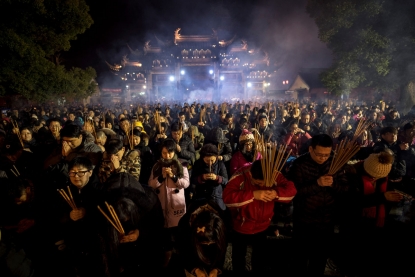 This picture taken late on February 15, 2018 shows people praying with incense sticks to celebrate the Lunar New Year, marking the Year of the Dog, at the Longhua temple in Shanghai.
(AFP / Johannes Eisele)
This picture taken late on February 15, 2018 shows people praying with incense sticks to celebrate the Lunar New Year, marking the Year of the Dog, at the Longhua temple in Shanghai.
(AFP / Johannes Eisele)The build-up starts about a month ahead, when the ubiquitous lanterns start to appear in the streets, shopping malls and people’s windows.
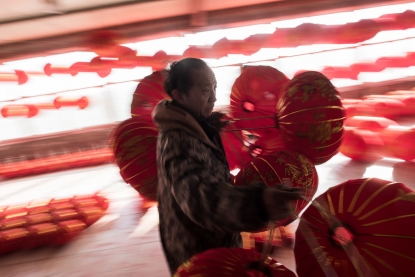 In this picture taken on January 11, 2018 a Chinese worker carries red lanterns for the upcoming Lunar New Year celebrations on February 15, at a factory in the village of Tuntou, in Hebei province southwest of Beijing.
(AFP / Fred Dufour)
In this picture taken on January 11, 2018 a Chinese worker carries red lanterns for the upcoming Lunar New Year celebrations on February 15, at a factory in the village of Tuntou, in Hebei province southwest of Beijing.
(AFP / Fred Dufour)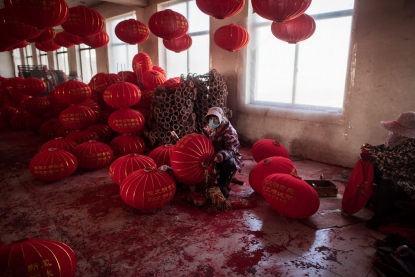 In this picture taken on January 11, 2018 a Chinese worker makes red lanterns ahead of the upcoming Lunar New Year celebrations on February 15, at a factory in the village of Tuntou in Hebei province southwest of Beijing.
(AFP / Fred Dufour)
In this picture taken on January 11, 2018 a Chinese worker makes red lanterns ahead of the upcoming Lunar New Year celebrations on February 15, at a factory in the village of Tuntou in Hebei province southwest of Beijing.
(AFP / Fred Dufour)
Then the train stations begin to get busier. You can feel a change in the atmosphere. And the week before it just gets crazy. This year I decided to cover the celebrations outside of Beijing for the first time, so I took a train to Chengdu in the center of the country. It was so packed that dozens of people had to stand the whole way there. That’s 26 hours. And the most incredible thing? It was one of the loveliest and friendliest atmospheres that I’ve encountered. Coming from a country where grumbling is a national pastime, I have to say I was quite impressed.
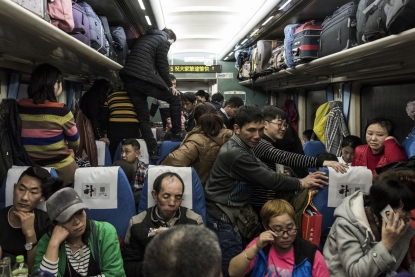 This photo taken on February 10, 2018 shows passengers travelling on a crowded train during the 26-hour journey from Beijing to Chengdu, in Shijiazhuang, as they head home ahead of the Lunar New Year.
(AFP / Fred Dufour)
This photo taken on February 10, 2018 shows passengers travelling on a crowded train during the 26-hour journey from Beijing to Chengdu, in Shijiazhuang, as they head home ahead of the Lunar New Year.
(AFP / Fred Dufour)The people were very polite to each other. To go to the toilet, you had to make your way through a wall of passengers and they all let you pass without so much as a sigh. I can’t imagine ever seeing such goodwill in similar conditions in Europe.
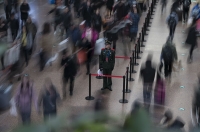
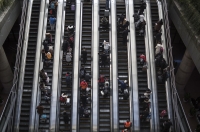
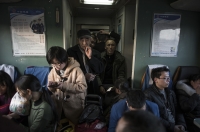
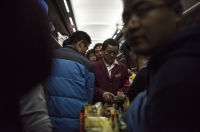

The big bang of the celebrations is usually on the eve of the New Year. In years past, that’s when the entirety of China seemed to set off fireworks to mark the occasion. They would start around 6 or 7 o’clock at night and last until dawn, with everyone in the streets -- adults, children, old people. It was a really nice moment, when everyone seemed to be united in joy.
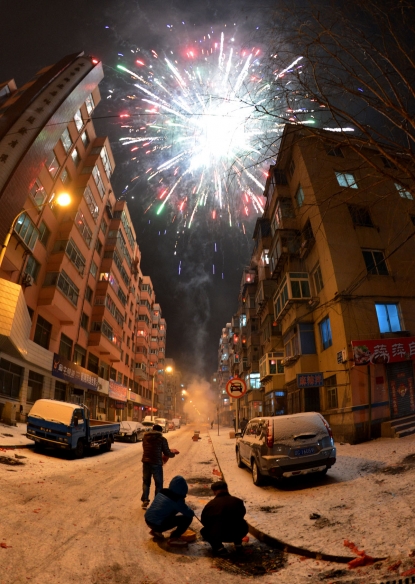 This photo taken on February 9, 2013 shows Chinese men letting off fireworks to welcome in the 'Year of the Snake' during the Lunar New Year celebrations in the Chinese border town of Dandong. (AFP / Mark Ralston)
This photo taken on February 9, 2013 shows Chinese men letting off fireworks to welcome in the 'Year of the Snake' during the Lunar New Year celebrations in the Chinese border town of Dandong. (AFP / Mark Ralston)For a photographer, it’ was a dream assignment as not only were the fireworks very visual, but, because they were not as tightly regulated here as in the West, there were many more of them. So a photographer was like a kid in a candy store.
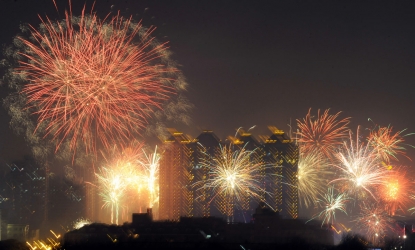 Fireworks light the night sky over Beijing to mark the start of the Lunar New Year early on February 3, 2011. (AFP / Peter Parks)
Fireworks light the night sky over Beijing to mark the start of the Lunar New Year early on February 3, 2011. (AFP / Peter Parks)This year was different, though, as fireworks were banned in most major cities, as authorities seek to lower winter pollution levels. You still had some here and there, but it wasn't anywhere near the scale of years past.
 People light fireworks after midnight to celebrate the Lunar New Year, marking the Year of the Dog, in Hancheng, Shaanxi province, on February 16, 2018.
(AFP / Fred Dufour)
People light fireworks after midnight to celebrate the Lunar New Year, marking the Year of the Dog, in Hancheng, Shaanxi province, on February 16, 2018.
(AFP / Fred Dufour)The days following the New Year are spent eating, going to fairs...
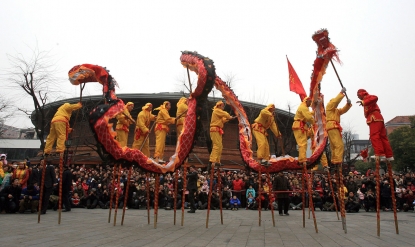 Performers stage a dragon dance in Wuhan, central China's Hubei province on February 6, 2012, to mark the final day of the Lunar festival. (AFP / Str)
Performers stage a dragon dance in Wuhan, central China's Hubei province on February 6, 2012, to mark the final day of the Lunar festival. (AFP / Str)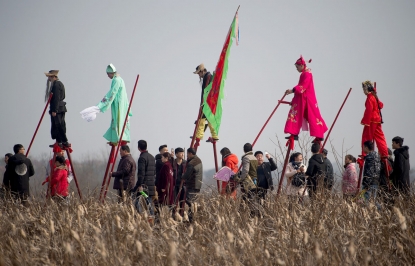 This photo taken on February 9, 2017 shows Chinese performers preparing to attend a local folk performance to celebrate the upcoming Lantern Festival in a village in Wuhan, central China's Hubei province.
(AFP / Str)
This photo taken on February 9, 2017 shows Chinese performers preparing to attend a local folk performance to celebrate the upcoming Lantern Festival in a village in Wuhan, central China's Hubei province.
(AFP / Str)
... eating, visiting family, eating, going to amusement rides...
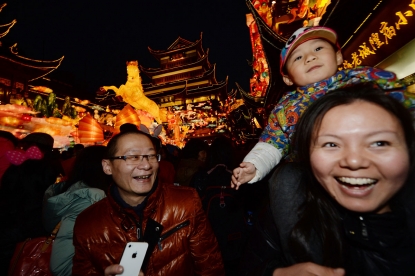 Large crowds visit the Lantern Festival and Lunar New Year decorations in the Yuyuan Gardens of Shanghai on February 15, 2014. (AFP / Mark Ralston)
Large crowds visit the Lantern Festival and Lunar New Year decorations in the Yuyuan Gardens of Shanghai on February 15, 2014. (AFP / Mark Ralston)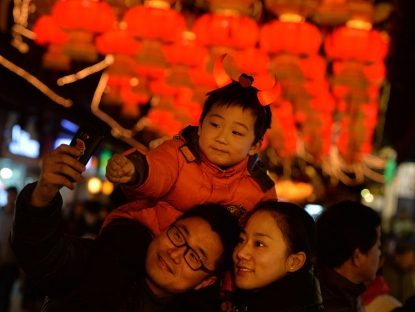 A young Chinese boy wearing horns poses for a photo with his parents as they visit the Lantern Festival decorations in the Yuyuan Gardens of Shanghai on February 15, 2014. (AFP / Mark Ralston)
A young Chinese boy wearing horns poses for a photo with his parents as they visit the Lantern Festival decorations in the Yuyuan Gardens of Shanghai on February 15, 2014. (AFP / Mark Ralston)
... eating, seeing traditional shows....
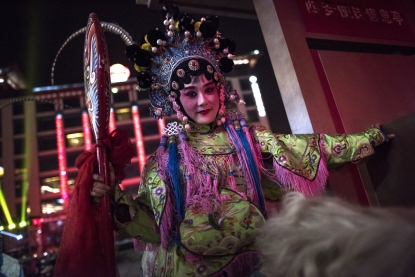 Dancers prepare to parade for the She Huo festival near Tang Paradise park in Xian, Shaanxi province, on February 14, 2018, ahead of the coming Lunar New Year, marking the Year of the Dog.
(AFP / Fred Dufour)
Dancers prepare to parade for the She Huo festival near Tang Paradise park in Xian, Shaanxi province, on February 14, 2018, ahead of the coming Lunar New Year, marking the Year of the Dog.
(AFP / Fred Dufour)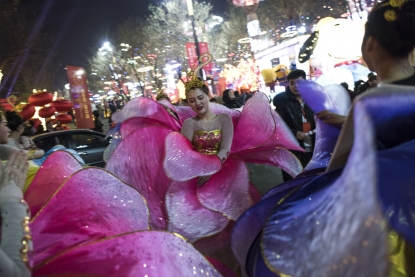 Dancers prepare to parade near Tang Paradise park in Xian, Shaanxi province, on February 14, 2018, ahead of the coming Lunar New Year, marking the Year of the Dog. (AFP / Fred Dufour)
Dancers prepare to parade near Tang Paradise park in Xian, Shaanxi province, on February 14, 2018, ahead of the coming Lunar New Year, marking the Year of the Dog. (AFP / Fred Dufour)
... eating, catching up on astrology news to see what the new year has in store for you (note to dogs -- it’s not looking good) and then eating some more. And then everyone heads back to their work lives. And the countdown begins for the following year.
This blog was written with Yana Dlugy in Paris.
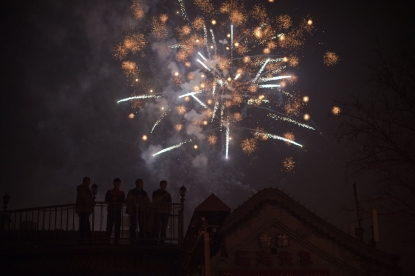 People watch fireworks on a street in Beijing on February 28, 2017, just after midnight marking the start of the Lunar New Year.
(AFP / Nicolas Asfouri)
People watch fireworks on a street in Beijing on February 28, 2017, just after midnight marking the start of the Lunar New Year.
(AFP / Nicolas Asfouri)


